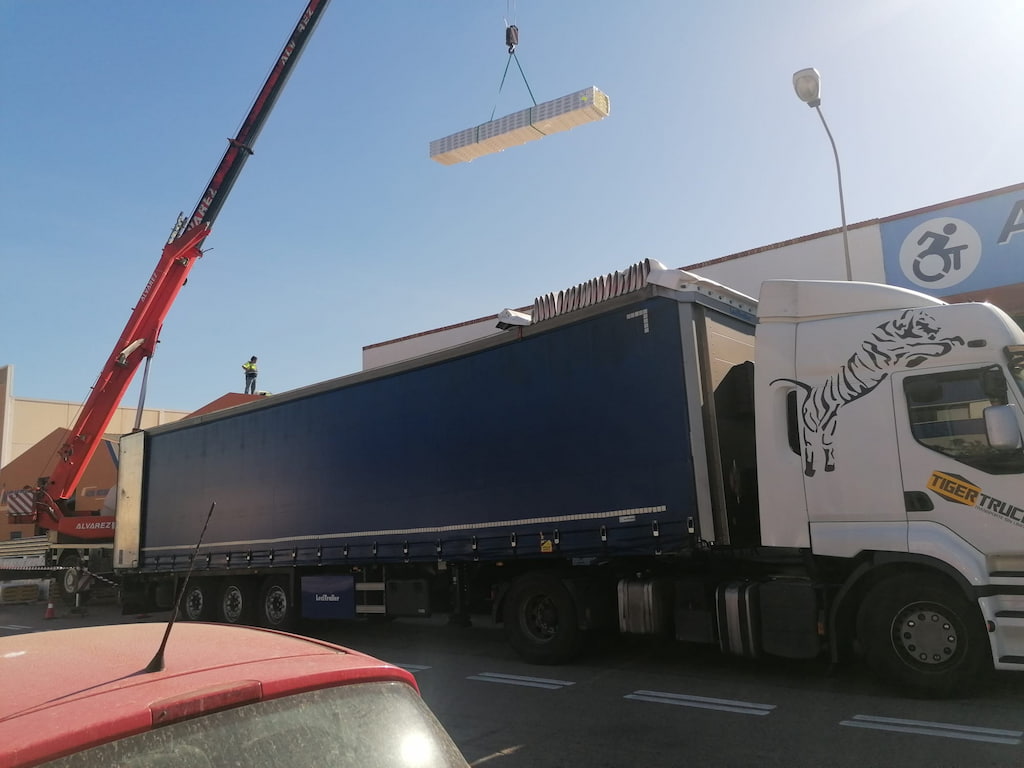The transport of construction materials is a key process in the industry, ensuring that supplies reach construction sites, warehouses, and distributors efficiently and safely. From bricks and cement to metal structures and bulk products, each type of material requires specific transport methods to maintain its integrity and reduce logistical costs.
In this article, we explore the main transportation options, key factors to consider, and the best solutions to optimize the process.
Types of Construction Material Transportation
Construction materials can be transported in various ways depending on their weight, volume, and fragility. Some require special protection against impacts or adverse weather conditions, while others can be shipped in bulk without risk of deterioration.
1. Full Truckload Transportation for Large Volumes
When a company needs to move a large quantity of materials, the most efficient option is full truckload transportation. This method ensures that the truck is exclusively dedicated to a single load, avoiding delays and ensuring that the materials arrive in perfect condition.
Full truckload transportation is one of the most efficient solutions for moving large volumes of construction materials. By allocating a truck specifically to a single shipment, delivery times are reduced, and product handling is minimized, decreasing the risk of damage during transit.
Additionally, this method provides greater flexibility in terms of routes and delivery schedules, as there is no need to coordinate multiple shipments in the same vehicle. This is particularly useful for construction projects that require a constant supply of materials without interruptions.
Common Materials Transported in This Method:
- Concrete blocks and bricks
- Beams and metal structures
- Prefabricated panels and drywall
2. International Groupage Transport for Smaller Shipments
For companies that don’t need to fill an entire truck, international groupage transport is an excellent alternative. This method combines multiple shipments in the same vehicle, optimizing costs and improving logistical efficiency.
Groupage transport is a great solution for businesses that don’t require a full truckload for their shipments. This method is ideal when construction materials take up little space, allowing transport to be shared with other shipments and reducing costs without compromising product safety.
Moreover, this method is particularly convenient for non-urgent deliveries, as transit times can be more flexible compared to exclusive shipments. Thanks to groupage, materials such as tiles, flooring, and installation tools can be efficiently distributed, ensuring they arrive in perfect condition while keeping expenses low.
Ideal for Transporting:
- Small quantities of cement and plaster
- Tiles, flooring, and other finishes
- Tools and installation materials
3. National Road Transport: The Most Flexible Option
National road transport is the most commonly used method for shipping construction materials within a country. Thanks to its speed and flexibility, it allows construction projects in both urban and rural areas to be supplied without the limitations of rail or maritime transport.
This transportation method stands out for its ability to reach any location while adapting to different types of cargo, making it an essential option for the sector. Additionally, since it is not dependent on external schedules, it offers faster and more adaptable delivery times, perfectly tailored to each project’s needs.
Best for Transporting:
- Heavy materials such as stones and aggregates
- Cement and pre-mixed concrete containers
- PVC, iron, and steel pipes for structures
4. Transporting Hazardous Goods in Construction
In some projects, it is necessary to move chemicals, gases or flammable materials, such as paints, solvents or adhesive liquids. For these cases, a specialised service such as the transport of dangerous goods by road, which follows strict safety regulations, is mandatory. Examples of dangerous goods in construction:
- Flammable paints and varnishes.
- Adhesives and sealants with chemical compounds.
- Gas cylinders and combustible products.
Compliance with ADR regulations is essential to ensure the safe transport of these materials and to avoid risks to workers and the environment.
Key Factors in Construction Material Transportation
To ensure efficient and safe transport of construction materials, several factors need to be considered:
- Load Protection: Depending on the material, it may be necessary to use special packaging, protective tarps, or adequate platforms to prevent damage during transit.
- Weight and Volume of the Material: The total weight of the load influences the choice of truck and permitted routes. Heavier materials require vehicles with greater capacity and resistance.
- Distance and Delivery Times: Delivery deadlines impact the choice of transport method. For urgent shipments, full truckload transport is the best option, while groupage is more convenient for smaller loads with more flexible schedules.
- Regulations and Compliance: Transporting certain materials may be subject to specific regulations, such as ADR regulations for hazardous goods or load restrictions in urban areas.
Tips for Optimizing Construction Material Transportation
- Plan in Advance: Coordinating deliveries and selecting the right transport method helps prevent delays at the construction site.
- Choose the Most Efficient Transport Option: Not all materials require the same handling. Assess whether full truckload, groupage, or specialized transport is necessary.
- Verify Local Regulations: Ensure that transportation complies with all regulations to avoid fines and delays.
- Work with a Reliable Logistics Operator: Specialized companies guarantee cost optimization and maximum safety for material transport.
Conclusion
The transport of construction materials is a crucial element in any building project, ensuring that supplies arrive on time and in perfect condition. The choice of transportation method will depend on factors such as volume, weight, fragility, and delivery distance, always prioritizing the best conditions for handling the materials.
To optimize logistics and reduce costs, selecting the right transport service—whether full truckload, groupage, national transport, or specialized hazardous goods transport—is key. Investing in an efficient logistics strategy is the best way to guarantee success in any construction project.
If you liked this article, we think you may be interested in: “All about the CMR Convention in the International Carriage of Goods”

